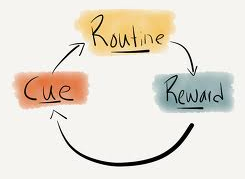By Luke McKenna
I have always enjoyed the start of a new school term. Usually characterised by a renewed sense of purpose, a spring in the step and some new goals to reach towards. But how do we keep ourselves and our students motivated and committed long enough to bring those goals to fruition?
It’s all about setting up great habits.
IT’S NOT JUST ABOUT MOTIVATION, WILLPOWER AND COMMITMENT
Most people (staff and students) struggle with maintaining the stamina required to keep striving for goals over a long period. While it’s relatively easy to do the right things early in the term (exercising, eating right, spiritual practice, etc), we cannot rely on willpower alone in order to stick to good actions as the weeks go on and things get harder. Over time, our willpower can become used up, or depleted, much like tired muscles (Baumeister & Tierney, 2012).
The truth is that relying on willpower, commitment and motivation rarely seems to work. Of course we need these things, but we need more than this – and so do the students that we teach. Instead, we may focus on setting up the right habits. After all, "we are what we repeatedly do. Excellence, then, is not an act, but a habit." - Aristotle.
HABITS CAN MAKE THINGS EASIER
If we want to stick with the behaviours that will lead to positive results in our lives, we must intentionally cultivate good habits. Habits are “the choices all of us deliberately make at some point, and then stop thinking about but continue doing, often everyday” (Duhigg, 2013).
Many of the decisions we make each day are habitual. One study suggests that habits account for approximately 45 percent of our everyday actions (Wood, Quinn, & Kashy, 2002). The great thing is that habits make our life easier as we don’t need to invest a lot of energy into deciding to do them. In fact, when a habit emerges, our “brain stops fully participating in decision making” (Duhigg, 2013). William James believed that “we should make our nervous system our ally, instead of our enemy” (James, 1984). So it’s all about setting ourselves up with habits that are working for us, not against us.
THE HABIT LOOP
In order to do this, we must understand and apply the habit loop.
Our habits can be broken into three steps:
1. The CUE / TRIGGER: the event that starts or triggers the habit (cues could include time of day, other people, a location, a preceding event or an emotional state).
2. The ROUTINE / BEHAVIOUR: the behaviour that you perform (the habit itself).
3. The REWARD: the benefit that is associated with the behaviour.
EXAMPLE
When we want to begin a new habit or cease an existing one, we use the habit loop. For example, if I would like to meditate more regularly (this is the routine / behaviour), I must find an appropriate trigger. For example, when I put the keys in the ignition of my car each morning (this is the cue / trigger), I will meditate for one minute (routine / behaviour)
New habits that we create should be small and easy to follow (start with a microhabit), so that we can achieve small wins and begin to strengthen the habit loop.
APPLICATION
Apply the habit loop to maintain your desired routines and behaviours when things get hard this term.
a) Decide on one routine or behaviour that you need to develop to set you up for success. (Make it small and specific).
b) Identify an existing cue or trigger to which you could attach your desired behaviour.
c) Enjoy the benefit or reward that is associated with your desired behaviour.
NB. The habit loop can also be used in reverse (to discontinue old habits) by replacing old behaviours with new ones when a trigger arises (swap it, don’t stop it), or by removing the trigger (don’t walk past the vending machine in the staffroom on the way back to your desk). But more on that another time…
For now, focus on this one question- What is one great habit that you will establish this term? Send me an email and let me know what habit you’re working on.
If you’re interested in applying this process for your students, “Step Up” has been designed for year 7 and year 8 students, and helps students to form great habits. Check it out here >>

